December 4, 2023
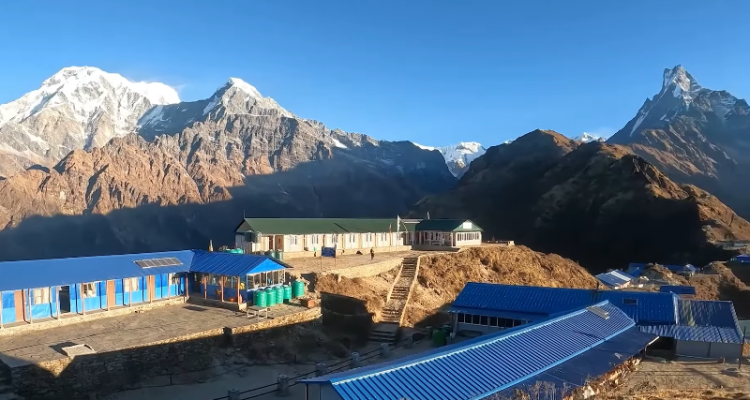
Introduction
Why Mardi Himal Trek?
What is the best time to do the Mardi Himal trek?
Physical fitness Requirements
Necessary permits and paperwork
Packing essentials and gear Recommendations
Getting There
Day By Day Mardi Himal Trek Itinerary
Accommodations on the Trail
Photography Tips:
Conclusion
The optimal time for the Mardi Himal trek is during the spring (March to May) and autumn (September to November) seasons. These periods offer favorable weather conditions with clear skies and moderate temperatures, ensuring an enjoyable and safe trekking experience. Avoiding the monsoon and winter months, the trek during spring allows for vibrant rhododendron blooms, while autumn offers clear views of the majestic Annapurna range. Embrace the beauty of Mardi Himal during these ideal seasons for an unforgettable journey through breathtaking landscapes and cultural encounters.
The Mardi Himal Trek is a hidden gem in the Annapurna region of Nepal, offering a captivating journey through diverse landscapes and providing awe-inspiring views of some of the world’s highest peaks. Starting from Kande, a short drive from Pokhara, the trek takes about 5 to 7 days to complete.
The trail winds through enchanting Gurung villages, allowing trekkers to immerse themselves in the local culture and experience the warm hospitality of the residents. As you ascend, the scenery transforms from lush rhododendron and oak forests to alpine meadows, offering a rich tapestry of natural beauty.
One of the highlights is the breathtaking panoramic views of the Annapurna Range, with prominent peaks like Machapuchare and Hiunchuli standing majestically in the backdrop. The trek reaches its pinnacle at Mardi Himal Base Camp, situated at an elevation of approximately 4,500 meters. Here, trekkers are rewarded with close-up views of Mardi Himal and the surrounding peaks, creating a surreal and unforgettable experience.
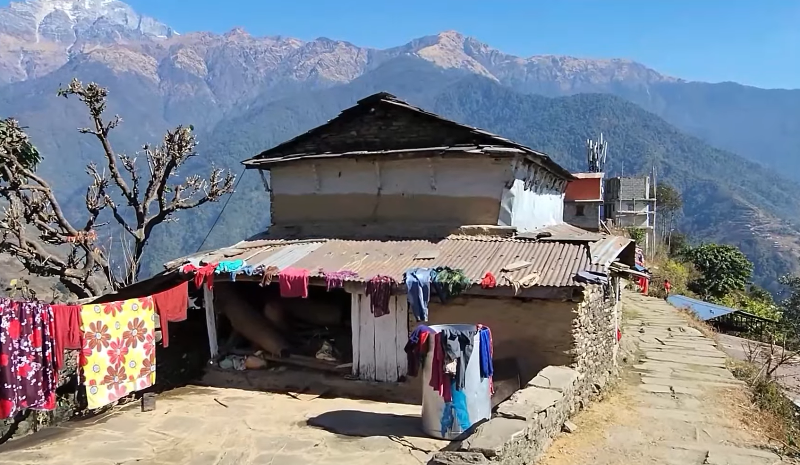
Typical House in Annapurna Mardi himal Trek
What sets the Mardi Himal Trek apart is its off-the-beaten-path nature. Compared to more popular routes, it provides a quieter and more serene trekking experience, allowing travelers to connect with nature and relish the tranquility of the mountains.
Why Mardi Himal Trek?
Mardi Himal Trek stands out as a captivating and less-traveled trekking destination, offering a unique blend of natural beauty, cultural richness, and adventure. This hidden gem in the Annapurna region of Nepal has been gaining popularity among trekking enthusiasts for several compelling reasons.
👉 Panoramic Views: Mardi Himal Trek provides awe-inspiring, panoramic views of the entire Annapurna mountain range, including iconic peaks like Machapuchare (Fishtail), Annapurna South, and Hiunchuli. The trek’s vantage points offer breathtaking sunrise and sunset vistas, creating a photographer’s paradise.
👉 Off-the-Beaten-Path Experience: Unlike the more crowded trekking routes in the region, Mardi Himal Trek offers a serene and less-frequented trail. This allows trekkers to immerse themselves in the tranquility of the Himalayas and experience a sense of solitude amidst nature.
👉 Rich Biodiversity: The trail traverses through lush rhododendron forests, charming traditional villages, and terraced fields, showcasing the region’s diverse flora and fauna. Trekkers have the opportunity to witness the local wildlife and immerse themselves in the vibrant colors of the surrounding landscapes.
👉 Cultural Encounters: Mardi Himal Trek provides an authentic cultural experience, allowing trekkers to interact with local communities such as Gurungs and Magars. The trek passes through traditional villages where visitors can observe the unique customs, traditions, and lifestyles of the indigenous people.
👉 Moderate Difficulty Level: With a moderate level of difficulty, Mardi Himal Trek is accessible to a wide range of trekkers, including those with moderate fitness levels. This makes it an ideal choice for both novice and experienced trekkers seeking a challenging yet achievable adventure.
👉 Short Duration: The trek can be completed in a relatively short time, typically within 7 to 10 days, making it suitable for those with limited time constraints. This allows trekkers to experience the beauty of the Annapurna region without committing to an extended period.
👉 Trekking Infrastructure: While less crowded than some popular routes, Mardi Himal Trek boasts adequate trekking infrastructure, including teahouses and lodges along the trail. This ensures a comfortable and safe trekking experience while still maintaining a sense of adventure.
👉 Secluded High Camp Experience: The trek includes a visit to High Camp, a more secluded and higher-altitude destination that provides stunning views of the surrounding peaks. This adds an element of exclusivity to the trek and rewards trekkers with a sense of accomplishment.
What is the best time to do the Mardi Himal trek?
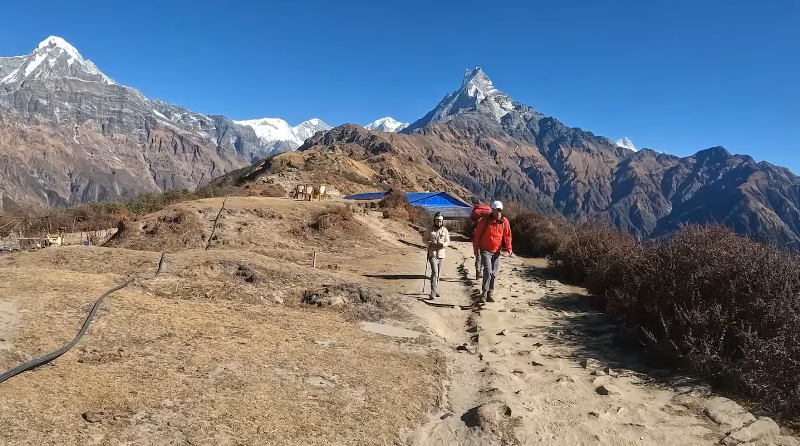
Wonderful view of Mount Machhapuchhre and near by Mountains
The Mardi Himal trek, located in the Annapurna region of Nepal, is best undertaken during the spring (March to May) and autumn (September to November) seasons.
During the spring, the weather is mild and stable, making it an ideal time for trekking. Daytime temperatures range from 10 to 20 degrees Celsius (50 to 68 degrees Fahrenheit), providing a comfortable environment for walking. The skies are generally clear, offering breathtaking views of the surrounding mountains, including the Annapurna and Machapuchare ranges. The trails are adorned with blooming rhododendron forests, adding to the scenic beauty.
Autumn is another excellent time for the Mardi Himal trek. The temperatures during the day are similar to spring, ranging from 10 to 20 degrees Celsius (50 to 68 degrees Fahrenheit). The skies are clear, ensuring panoramic views of the Himalayan peaks. The trekking conditions are favorable, and the trails are relatively dry, reducing the risk of slips and falls.
In both seasons, the evenings and nights can get chilly, with temperatures dropping to around 5 degrees Celsius (41 degrees Fahrenheit) or lower. It is advisable to bring warm layers for the evenings and nights. Additionally, during these seasons, the overall safety conditions are more predictable, with lower chances of encountering extreme weather conditions such as heavy rainfall or snowfall.
It’s crucial to note that trekking during the monsoon season (June to August) is not recommended due to the heavy rainfall, which can lead to slippery and dangerous trail conditions. Likewise, winter (December to February) brings colder temperatures and increased snowfall, making the trek more challenging and potentially hazardous.
Ultimately, choosing the best time for the Mardi Himal trek in spring or autumn ensures a safer and more enjoyable experience, with favorable weather conditions and stunning landscapes. Always check the current weather forecasts and trail conditions before embarking on any trekking adventure for the most up-to-date information on safety.
Physical fitness Requirements
The Mardi Himal trek, nestled in the Annapurna region of Nepal, demands a moderate level of physical fitness. Trekkers should possess good cardiovascular endurance, as the trail involves steep ascents and descents at varying altitudes. Core strength and leg muscles are crucial for navigating uneven terrain. Stamina is essential for daily hikes lasting around 5-6 hours. Adequate preparation should include cardiovascular exercises, strength training, and uphill walking. Altitude acclimatization is vital due to the trek’s elevation gain. A well-rounded fitness routine, including aerobic and anaerobic exercises, enhances overall endurance and resilience, ensuring a more enjoyable and successful Mardi Himal trekking experience.
1. Annapurna Conservation Area Permit (ACAP):
For Foreign Nationals:
Procedure:
Documents Needed:
For Indian Nationals:
Validity:
The ACAP permit is typically valid for the duration of your trek within the Annapurna Conservation Area.
Keep Permits Handy: Always carry a physical copy of your ACAP permit during the trek, as it may be checked at various checkpoints.
Important Tips:
The Mardi Himal Trek is a beautiful trek in the Annapurna region of Nepal, offering stunning views of the Himalayas and a less crowded experience compared to some other popular treks in the area. When preparing for the Mardi Himal Trek, it’s crucial to pack wisely to ensure you have everything you need for a comfortable and safe journey. Here’s a list of packing essentials and gear recommendations:
Clothing:
Gear:
Miscellaneous:
Optional:
Remember to adjust your packing list based on the specific season and weather conditions during your trek. It’s also a good idea to check the local regulations and guidelines before embarking on your journey.
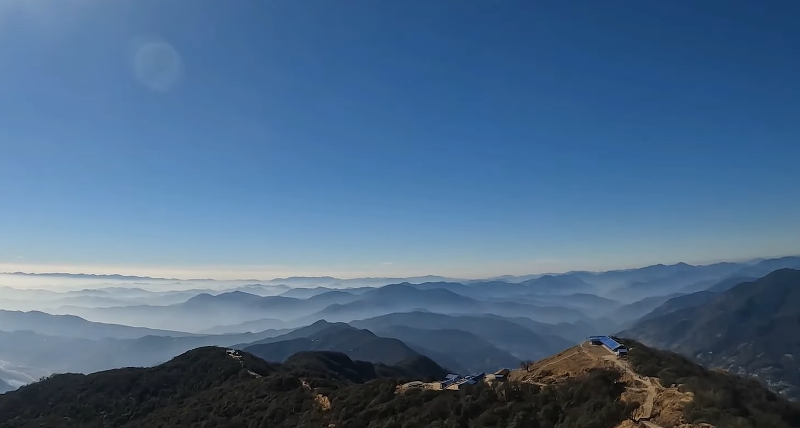
Rolling green hill view from Badal Danda during Mardi Himal trek
To get to Mardi Himal Base Camp from Kathmandu, you’ll typically follow these steps:
1. Kathmandu to Pokhara:
Start by traveling from Kathmandu to Pokhara. This can be done by either taking a domestic flight from Tribhuvan International Airport to Pokhara Airport or by using tourist buses that operate between Kathmandu and Pokhara.
2. Pokhara to Phedi:
From Pokhara, make your way to Phedi, which is the starting point of the Mardi Himal Trek. This journey can be covered by private vehicle, local bus, or taxi.
3. Phedi to Dhampus:
Begin your trek from Phedi and walk to Dhampus. Dhampus is a scenic village along the route, and you can choose to stay overnight here or continue further.
4. Dhampus to Forest Camp:
Continue trekking from Dhampus to Forest Camp. The trail takes you through beautiful rhododendron forests, providing a lush and picturesque environment.
5. Forest Camp to Low Camp:
Trek from Forest Camp to Low Camp. As you ascend, you’ll notice changes in the landscape and panoramic views of the surrounding mountains.
6. Low Camp to High Camp:
Continue your trek from Low Camp to High Camp. The scenery becomes more alpine, and you’ll gain altitude. High Camp serves as a crucial point for acclimatization.
7. High Camp to Mardi Himal Base Camp:
The final leg of the trek takes you from High Camp to Mardi Himal Base Camp. Enjoy breathtaking views of Mardi Himal, Machapuchare, and the Annapurna Range.
Day 1: Kathmandu to Pokhara
Altitude: Kathmandu (1400m / 4593ft), Pokhara (820m / 2690ft)
On the first day of the Mardi Himal trek, we bid farewell to the bustling streets of Kathmandu and embarked on a journey towards the picturesque city of Pokhara. The morning began with a hearty breakfast in the capital, situated at an altitude of 1400 meters. Whether by a scenic road trip or a brief flight, the transition from Kathmandu to Pokhara offered glimpses of Nepal’s diverse landscapes. As we arrived in Pokhara, nestled at an altitude of 820 meters, the serene ambiance of Lakeside greeted us. After checking into our accommodation, we indulged in a leisurely lunch at a local restaurant, absorbing the laid-back charm of Pokhara. The afternoon unfolded with a chance to explore the lakeside area, its vibrant markets, and the tranquil Phewa Lake. In the evening, a briefing with our trekking guide set the tone for the upcoming adventure, followed by a delightful dinner in Pokhara. With the excitement of the trek ahead, we retired for the night, eager to commence the Mardi Himal journey.
Day 2: Pokhara to Kande, then trek to Rest Camp (2600m)
Altitude: Kande (1770m / 5807ft), Rest Camp (2600m / 8530ft)
The trek from Pokhara to Rest Camp via Kande is a mesmerizing journey through the heart of the Annapurna region. Commencing from the picturesque city of Pokhara in the early morning, travelers embark on a scenic 16-kilometer road trip to Kande. The drive offers glimpses of rural life and lush landscapes. Upon reaching Kande, a charming village, the trek officially commences. Surrounded by terraced fields and Himalayan vistas, Kande serves as the gateway to the mountains. The trail gradually ascends, revealing panoramic views of snow-capped peaks. After a few hours of trekking, adventurers reach Rest Camp at 2600 meters, a tranquil haven nestled in the Himalayan foothills.
Day 3: Rest Camp to High Camp
Altitude: High Camp (3540m / 11614ft)
Embarking from Rest Camp at 2600 meters, the trek to High Camp unfolds with a journey through Low Camp and Badal Danda. The trail winds through enchanting landscapes, encompassing dense forests and open meadows. Low Camp offers a serene interlude, an ideal spot for a refreshing break amidst nature’s embrace. After a delightful lunch at Badal Danda, a captivating locale, the trail skirts the edge of mountain ridges, providing awe-inspiring views of the surrounding peaks. As the path ascends, the air becomes crisper, and the panorama widens. Finally, the trek culminates at High Camp, an elevation of heightened tranquility, offering a splendid vantage point for the spectacular mountainous scenery.
Day 4: High Camp to Mardi View Point, then back to Siding
Altitude: Mardi View Point (4500m / 14764ft), Siding (1280m / 4199ft)
Embarking from High Camp, the trek to Mardi View Point unfolds with challenging yet rewarding terrain. The journey takes trekkers through alpine landscapes, navigating rocky trails and lush rhododendron forests. The ascent to Mardi View Point, situated at an elevation of around 4,500 meters, rewards adventurers with a breathtaking panorama of the Annapurna Range, including iconic peaks like Machapuchare and Hiunchuli. After soaking in the majestic views, trekkers descend to Siding, a quaint village nestled amidst terraced fields and traditional dwellings. The trail presents diverse flora and fauna, and encounters with friendly locals add cultural richness to the trek. Siding offers a serene conclusion to the day, allowing trekkers to unwind and appreciate the tranquility of the Himalayan foothills.
The view from Mardi View Point showcases a spectacular panorama of the Annapurna Range, featuring several prominent peaks. While the exact visibility may depend on weather conditions, here are some of the notable mountains you might witness along with their approximate altitudes:
These majestic peaks collectively form an awe-inspiring backdrop, providing trekkers with a memorable and rewarding experience at Mardi View Point.
Day 5:Siding to Pokhara
Altitude: Pokhara (820m / 2690ft)
The journey from Siding to Pokhara marks the conclusion of your trek, offering a comfortable transition from the serene Himalayan foothills to the bustling city. After a rejuvenating breakfast in Siding, trekkers typically opt for a convenient jeep ride to Pokhara. The journey through picturesque landscapes and winding roads takes approximately 2 and a half hours, providing travelers with a chance to reflect on the trekking adventures while enjoying the changing scenery. The route often meanders through charming villages, offering glimpses of local life. Upon reaching Pokhara, trekkers can unwind, celebrate their achievements, and relish the vibrant atmosphere of this lakeside city before departing for their next adventure or journey home.
Day 6: Pokhara to Kathmandu
Altitude: Kathmandu (1400m / 4593ft)
Embarking on a journey from Pokhara’s Rastrabank Chok at 7:30 am, the bus ride to Kathmandu promises a scenic adventure through Nepal’s breathtaking landscapes. Passing charming villages and the majestic Annapurna mountain range, the journey offers a picturesque experience, though the duration can vary. For those seeking a quicker alternative, a 25-minute flight from Pokhara Airport to Kathmandu is available, providing a swift and convenient option. The aerial route treats travelers to stunning views of the Himalayas, creating a memorable and efficient travel experience. Whether by bus or air, the transition from Pokhara to Kathmandu is an opportunity to absorb the diverse beauty of Nepal.
Accommodations on the Trail
During the Mardi Himal trek, you’ll find comfortable accommodations. Rooms are private and come with lockers to keep your things safe. Bathrooms are shared but kept clean. Dining areas are communal, allowing you to meet other trekkers. The lodges prioritize cleanliness, offering a fresh and pleasant stay. You can enjoy local meals prepared on-site. Rooms usually have twin beds for sharing, ensuring a good night’s sleep after a day of trekking. Overall, the accommodations aim to provide a cozy and hygienic environment along the beautiful Mardi Himal trail.
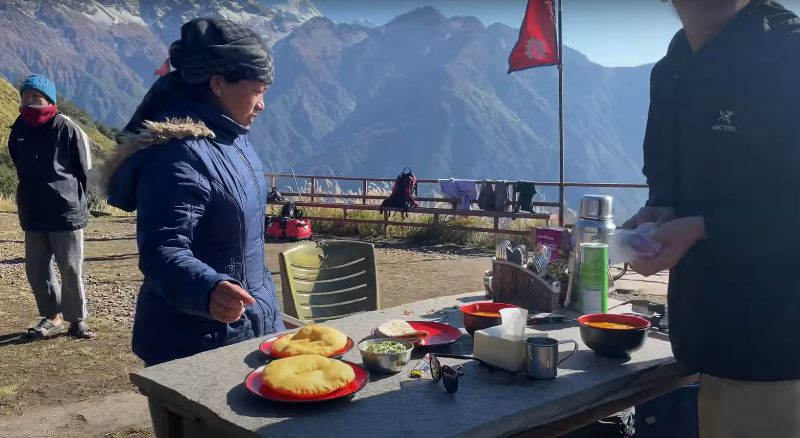
Food options during Mardi Himal Trek
The food options during the Mardi Himal trek can vary depending on the teahouses or lodges you visit along the route. However, here’s a list of foods that you might find available during the trek:
Remember that the availability of some items can vary, and the further you trek, the more limited the options might become. It’s always a good idea to check with the teahouse owner about the available menu items. Additionally, keep in mind that fresh and locally sourced ingredients are commonly used, providing a unique and authentic culinary experience during your trek.
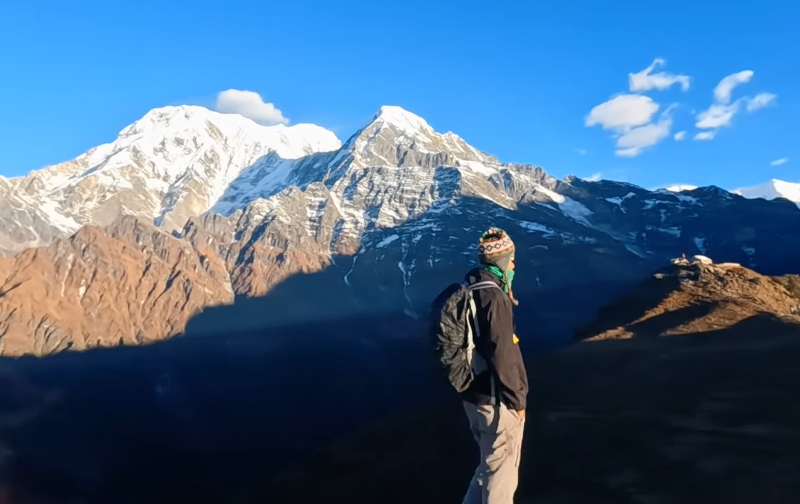
Magical view of Annapurna south and Hiunculi
Mardi Himal Trekking offers breathtaking landscapes and diverse scenery that provide excellent opportunities for photography. Here are some photography tips and must-capture moments during your Mardi Himal trek:
Photography Tips:
Golden Hours:
Capture the stunning landscapes during the golden hours—early morning and late afternoon. The soft, warm light during these times enhances the natural beauty of the surroundings.
Weather Considerations:
Be prepared for changing weather conditions. Clouds, mist, and rain can add drama to your photos. Capture the moody and mysterious atmosphere when the weather is less predictable.
Portrait Shots:
Include fellow trekkers, locals, and guides in your shots to add a human element to your photos. Candid portraits can tell a powerful story of your trekking experience.
Use a Tripod:
For low light conditions or long-exposure shots, bring a lightweight tripod. This can be particularly useful for capturing night scenes, starry skies, or waterfalls.
Wide-angle Lens:
Bring a wide-angle lens to capture the vast landscapes and towering peaks. This will help you showcase the grandeur of the Himalayas.
Details and Macro Shots:
Don’t forget to capture the smaller details, such as colorful flowers, unique rocks, or local architecture. Macro shots can add variety to your photo collection.
Storytelling Sequences:
Capture a series of photos that tell a story. This could include the trekking journey, interactions with locals, and the changing landscapes as you ascend.
Natural Framing:
Look for natural elements like overhanging branches or archways to frame your shots. This technique adds depth and interest to your photographs.
Must-Capture Moments:
Base Camp Views:
Once you reach Mardi Himal Base Camp, capture the panoramic views of the surrounding peaks, including Machapuchare and Annapurna South.
Sunrise and Sunset:
Witness and photograph the sunrise and sunset over the Himalayan peaks. The changing colors of the sky will create stunning visual moments.
Local Culture:
Capture the unique culture of the region, including traditional houses, prayer flags, and local customs. Engage with locals and seek permission before taking their photos.
Rhododendron Forests:
If you trek during the blooming season (spring), the rhododendron forests will be a vibrant splash of colors. Capture the contrast between the colorful flowers and the greenery.
Snowy Landscapes:
If trekking during winter, the landscapes will be covered in snow. Capture the serene beauty of snow-covered trails, trees, and mountains.
Conclusion
The optimal time for the Mardi Himal trek is during the spring (March to May) and autumn (September to November) seasons. These periods offer favorable weather conditions with clear skies and moderate temperatures, ensuring an enjoyable and safe trekking experience. Avoiding the monsoon and winter months, the trek during spring allows for vibrant rhododendron blooms, while autumn offers clear views of the majestic Annapurna range. Embrace the beauty of Mardi Himal during these ideal seasons for an unforgettable journey through breathtaking landscapes and cultural encounters.